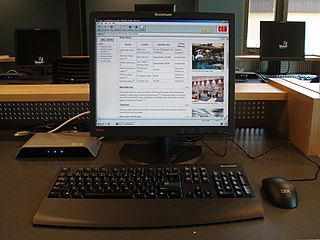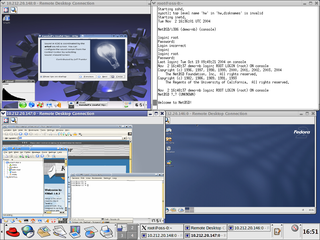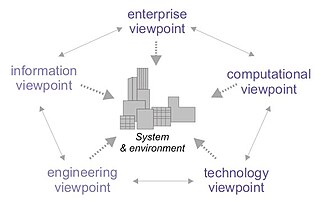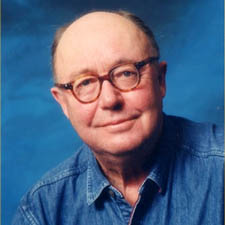Andrew James Herbert, OBE, FREng (born 1954) is a British computer scientist, formerly Chairman of Microsoft Research, for the Europe, Middle East and Africa region.
Andrew James Herbert, OBE, FREng (born 1954) is a British computer scientist, formerly Chairman of Microsoft Research, for the Europe, Middle East and Africa region.
Herbert received a bachelor's of science degree in computational science from the Leeds University in 1975, and a PhD degree in computer science from Cambridge University in 1978 for his work on "A Microprogrammed Operating System Kernel".
In 1978 he started working at the University of Cambridge Computer Laboratory as assistant lecturer under Maurice Wilkes and Roger Needham in the Computer Laboratory, and worked with others on the "Cambridge Model Distributed System". In 1985 he left Cambridge to found his own contract research company (Architecture Projects Ltd – APM Ltd), which led projects to develop ANSA, the Advanced Network Systems Architecture. In 1996 he had founded another sister company called Digitivity to develop a product to enable the secure deployment of Java clients for business-to-business applications. Two years later he joined Citrix Systems Inc. following their acquisition of APM and Digitivity to become Director of Advanced Technology. In 2001 he joined Microsoft Research in Cambridge as an assistant director, and became managing director in April 2003. In 2010 he became chairman of Microsoft Research EMEA. He retired from Microsoft in September 2011.
Herbert is a Fellow of the Royal Academy of Engineering, a Fellow of the British Computer Society and a former Liveryman of the City of London Worshipful Company of Information Technologists. He is an Emeritus Fellow of Wolfson College, Cambridge and a member of St John's College, Cambridge.
Herbert was appointed Officer of the Order of the British Empire (OBE) in the 2010 New Year Honours. [1]
Outside of computing, Herbert's interests include flying and restoring vintage aircraft, computer conservation and building scale working models of steam railway locomotives. He owns and operates a 1953 DHC-1 Chipmunk and shares ownership and operation of a DH87b Hornet Moth aircraft.
Now in retirement, Herbert is chairman of trustees for the National Museum of Computing at Bletchley Park. He is also the manager of a project to construct a working replica of the Cambridge EDSAC computer at the museum.
He keeps a working 1967 Elliott 903 computer at his home.
Herbert's research interests include computer networking, operating systems, distributed computing, programming languages and large-scale data driven systems. His most significant research achievements were an operating system for the Cambridge CAP Computer, his contributions to the Cambridge Model Distributed System and the Advanced Networked Systems Architecture.
The Advanced Networked Systems Architecture (ANSA) was an applied research programme starting in the 1980s as part of the UK Alvey Programme. ANSA aimed to develop a distributed systems software architecture to support applications integration in enterprise-wide systems. The ANSA work included support for interactive multi-media services, object technology for World Wide Web applications, distributed systems management, mobile object systems and security for electronic commerce. ANSA was an early example of what became known as 'middleware'.
In the 1990s "ANSAWare" software based on the ANSA architecture was used by many organisations ahead of the widespread availability of commercial, CORBA-based products for distributed computing. Notable successes included the NASA Astrophysics Data System (ADS), a European radio pager system and the online customer service system for a major UK utility. As part of his ANSA work, Herbert played an active role in many standards and consortia for distributed computing including TINA-C, RM-ODP, OSF DCE and OMG CORBA.
Herbert created a Cambridge UK company, called Architecture Projects Management Ltd (APM), to employ the ANSA research team. As ANSA matured APM developed a parallel software consulting business to help companies adopt ANSA ideas and exploit ANSAware, CORBA and Internet technologies. A key development during this period was E2S, a smart card-based architecture for end-to-end secure business-to-business transactions. In 1996 APM spun out further business called Digitivity, with offices in Cambridge UK and Palo Alto, California, USA to develop an Internet browser security product. In 1998 APM and Digitivity were acquired by Citrix Systems of Ft Lauderdale, Florida, USA and Herbert took up the position of Director for Advanced Technologies where he remained until joining Microsoft in 2001.
Herbert published several books and articles, [2] a selection:
In distributed computing, a remote procedure call (RPC) is when a computer program causes a procedure (subroutine) to execute in a different address space, which is written as if it were a normal (local) procedure call, without the programmer explicitly writing the details for the remote interaction. That is, the programmer writes essentially the same code whether the subroutine is local to the executing program, or remote. This is a form of client–server interaction, typically implemented via a request–response message passing system. In the object-oriented programming paradigm, RPCs are represented by remote method invocation (RMI). The RPC model implies a level of location transparency, namely that calling procedures are largely the same whether they are local or remote, but usually, they are not identical, so local calls can be distinguished from remote calls. Remote calls are usually orders of magnitude slower and less reliable than local calls, so distinguishing them is important.

In computer networking, a thin client, sometimes called slim client or lean client, is a simple (low-performance) computer that has been optimized for establishing a remote connection with a server-based computing environment. They are sometimes known as network computers, or in their simplest form as zero clients. The server does most of the work, which can include launching software programs, performing calculations, and storing data. This contrasts with a rich client or a conventional personal computer; the former is also intended for working in a client–server model but has significant local processing power, while the latter aims to perform its function mostly locally.

An interface description language or interface definition language (IDL) is a generic term for a language that lets a program or object written in one language communicate with another program written in an unknown language. IDLs are usually used to describe data types and interfaces in a language-independent way, for example, between those written in C++ and those written in Java.

Citrix Systems, Inc. is an American multinational cloud computing and virtualization technology company that provides server, application and desktop virtualization, networking, software as a service (SaaS), and cloud computing technologies. Citrix claims that their products are used by over 400,000 clients worldwide, including 99% of the Fortune 100 and 98% of the Fortune 500.

The Department of Computer Science and Technology, formerly the Computer Laboratory, is the computer science department of the University of Cambridge. As of 2023 it employed 56 faculty members, 45 support staff, 105 research staff, and about 205 research students. The current Head of Department is Professor Alastair Beresford.

Xen is a free and open-source type-1 hypervisor, providing services that allow multiple computer operating systems to execute on the same computer hardware concurrently. It was originally developed by the University of Cambridge Computer Laboratory and is now being developed by the Linux Foundation with support from Intel, Citrix, Arm Ltd, Huawei, AWS, Alibaba Cloud, AMD, Bitdefender and epam.
The Distributed Computing Environment (DCE) is a software system developed in the early 1990s from the work of the Open Software Foundation (OSF), a consortium founded in 1988 that included Apollo Computer, IBM, Digital Equipment Corporation, and others. The DCE supplies a framework and a toolkit for developing client/server applications. The framework includes:

A diskless node is a workstation or personal computer without disk drives, which employs network booting to load its operating system from a server.
Microsoft Research (MSR) is the research subsidiary of Microsoft. It was created in 1991 by Richard Rashid, Bill Gates and Nathan Myhrvold with the intent to advance state-of-the-art computing and solve difficult world problems through technological innovation in collaboration with academic, government, and industry researchers. The Microsoft Research team has more than 1,000 computer scientists, physicists, engineers, and mathematicians, including Turing Award winners, Fields Medal winners, MacArthur Fellows, and Dijkstra Prize winners.

Reference Model of Open Distributed Processing (RM-ODP) is a reference model in computer science, which provides a co-ordinating framework for the standardization of open distributed processing (ODP). It supports distribution, interworking, platform and technology independence, and portability, together with an enterprise architecture framework for the specification of ODP systems.
Desktop virtualization is a software technology that separates the desktop environment and associated application software from the physical client device that is used to access it.
In computing, network virtualization is the process of combining hardware and software network resources and network functionality into a single, software-based administrative entity, a virtual network. Network virtualization involves platform virtualization, often combined with resource virtualization.
User environment management is the management of a computer user's experience within their desktop environment.

Roger Michael Needham was a British computer scientist.
A reliable multicast is any computer networking protocol that provides a reliable sequence of packets to multiple recipients simultaneously, making it suitable for applications such as multi-receiver file transfer.

The Institute for System Programming (ISP) of the Russian Academy of Sciences was founded on January 25, 1994, on the base of the departments of System Programming and Numerical Software of the Institute for Cybernetics Problems of the RAS. ISP RAS belongs to the Division of Mathematical Sciences of the RAS.

Wyse Technology, Inc., or simply Wyse, was an independent American manufacturer of cloud computing systems. As of 2012, Wyse is a subsidiary of Dell. Wyse are best remembered for their video terminal line introduced in the 1980s, which competed with the market-leading Digital. They also had a successful line of IBM PC compatible workstations in the mid-to-late 1980s. But starting late in the decade, Wyse were outcompeted by companies such as eventual parent Dell. Current products include thin client hardware and software as well as desktop virtualization solutions. Other products include cloud software-supporting desktop computers, laptops, and mobile devices. Dell Cloud Client Computing is partnered with IT vendors such as Citrix, IBM, Microsoft, and VMware.
An Internet operating system, or Internet OS, is any type of operating system designed to run all of its applications and services through an Internet client, generally a web browser. The advantages of such an OS would be that it would run on a thin client, allowing cheaper, more easily manageable computer systems; it would require all applications to be designed on cross-platform, open standards; and would not tie a user's applications, documents, and preferences to a single computer, but rather place them in the Internet cloud. The Internet OS has also been promoted as the perfect type of platform for software as a service.
The Cambridge Distributed Computing System is an early discontinued distributed operating system, developed in the 1980s at Cambridge University. It grew out of the Cambridge Ring local area network, which it used to interconnect computers.
Citrix Virtual Apps is an application virtualization software produced by Citrix Systems that allows Windows applications to be accessed via individual devices from a shared server or cloud system.